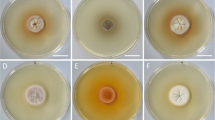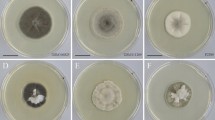Abstract
Three flagellates of the family Trypanosomatidae were isolated from mango fruits (Mangifera indica) and from the stems of clover (Trifoliumglomeratum) and Amaranth (Amaranthus retroflexus) in southeastern Spain and were adapted to in vitro culture in monophase media. The parasites showed an ultrastructural pattern similar to that of other species of the genus Phytomonas. Mango and clover isolates differed from amaranth isolates in ultrastructural terms. The isolates were characterized by isoenzymatic analysis and by kDNA analysis using five different restriction endonucleases. With eight of the nine enzymatic systems, mango and clover isolates were distinguished from those of amaranth. Nevertheless, with the enzymes malate dehydrogenase and superoxide dismutase, flagellates isolated from clover were differentiated from those isolated from mango. Electrophoretic and restriction-endonuclease analysis of kDNA minicircles showed similar restriction cleavage patterns for the isolates from mango and clover, whereas the patterns of the amaranth isolates differed. The results of the present study confirm that the strains isolated from mango and clover constitute a phylogenetically closely related group of plant trypanosomatids, which is more distantly related to the strain isolated from amaranth. The similarities in the results obtained for isolates from mango and clover foliage, on the one hand, and those obtained from tomato and cherimoya fruits (studied previously), on the other, as well as the geographic proximity of the different plants support the contention that only one strain is involved, albeit one strain that can parasitize different plants. Furthermore, some of the plants appear to act as reservoirs for the parasites. On the other hand, the metabolism studies using [1H]-nuclear magnetic resonance spectroscopy did not reveal that the catabolism of Phytomonas in general follows a pattern common to all the species or isolates. Phytomonas are incapable of completely degrading glucose, excreting a large part of their carbon skeleton into the medium as fermentative metabolites (acetate, ethanol, glycine, glycerol, and succinate).
Similar content being viewed by others
Author information
Authors and Affiliations
Additional information
Received: 16 June 1997 / Accepted: 7 November 1997
Rights and permissions
About this article
Cite this article
Sánchez-Moreno, M., Fernández-Becerra, C., Fernández-Ramos, C. et al. Trypanosomatid protozoa in plants of southeastern Spain: characterization by analysis of isoenzymes, kinetoplast DNA, and metabolic behavior. Parasitol Res 84, 354–361 (1998). https://doi.org/10.1007/s004360050410
Issue Date:
DOI: https://doi.org/10.1007/s004360050410




